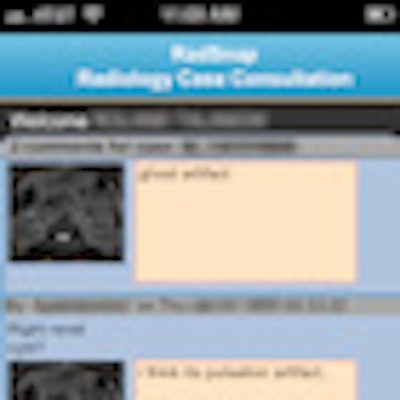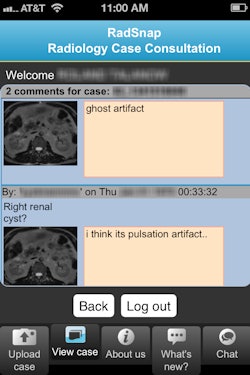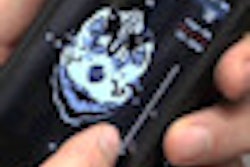
Wouldn't it be great if an app delivered imaging consultations on difficult cases straight to your smartphone? Wish no more: A new app called RadSnap allows physicians to take a picture of a case with their smartphone and submit it to a network of experts for advice.
Introduced by radiologist Dr. Roland Talanow at RSNA 2012, the app is especially designed to help physicians who order or perform medical imaging in remote and economically undeveloped regions of the world. Such physicians may practice alone without direct access to others for a second opinion, and they may not have access to PACS or teleradiology to transmit studies to a hospital for consultation, Talanow told AuntMinnie.com in an interview.
 RadSnap is a free tool for obtaining consultations on difficult cases. Image courtesy of Dr. Roland Talanow.
RadSnap is a free tool for obtaining consultations on difficult cases. Image courtesy of Dr. Roland Talanow.
RadSnap works with iPhones, iPads, or Android smartphones and tablets to transmit images from difficult cases for interpretation by radiologists associated with Radiolopolis, a nonprofit radiology consortium Talanow founded in 2009.
More than 12,000 radiologists and radiologic technologists worldwide participate in research, education, and practice management programs sponsored by Radiolopolis, Talanow said. Membership is limited to credentialed clinical and academic radiology professionals.
Radiologists who volunteer for RadSnap also participate in the organization's "I Need Help" practice group, which provides free guidance to fellow members on a semiautomated basis. RadSnap expands the service to the general medical community while greatly reducing response times, he said.
How it works
Physicians can initiate an inquiry by snapping a photo of the image in question -- an x-ray on a viewbox or MRI scan on a display monitor, for example -- with the built-in camera on their smartphones.
The image is loaded into the app's display software, and the user can zoom and crop the image to highlight findings. The referring physician is responsible for eliminating patient identifiers to protect patient privacy.
A short case description and key question can be typed in. Drop-down menus capture information about the imaging modality, body region, imaging plane/orientation, and imaging subspecialty to help direct the case to a qualified consultant.
The case is then submitted to the radiologist network and posted on the Radiolopolis website for a call for opinion.
Connection with a Radiolopolis radiologist is established within a few hours after the initial inquiry, Talanow said. Participants can then engage in a short discussion with text messages using the image as a reference on the mobile device. Relevant case studies and other reference material, such as staging tools for differential diagnoses, can also be downloaded from the Radiolopolis website.
The inspiration for RadSnap came last year during a conversation between Talanow and a chiropractor.
"He mentioned that it would be good if he could take pictures of an x-ray on a viewbox with his iPhone and send it to the radiologist," Talanow said. "He wanted just a quick answer, not a full consultation or a long wait for an answer from a consulting physician."
What about malpractice?
With radiologists (and other physicians) so concerned about malpractice these days, do physicians participating in RadSnap expose themselves to legal liability for the cases for which they're offering opinions?
 Dr. Roland Talanow.
Dr. Roland Talanow.
Talanow doesn't think so, as RadSnap is not a traditional second opinion or consultation system for which insurance reimbursement is provided. He likens it to an informal conversation that might occur between colleagues from different departments at a hospital.
"How you handle the information you receive is naturally your own responsibility -- just use common sense," Talanow said.
Another potential issue is the diagnostic quality of images produced by a smartphone's camera. A number of studies have indicated that for some applications, images sent from a PACS workstation and displayed on a smartphone could work in a pinch. But what happens when the smartphone is the acquisition device?
Talanow acknowledges that this question hasn't been answered, and the firm plans to conduct a study to see which modalities and clinical situations are best suited to the RadSnap approach. He points out that some modalities may not require as high a resolution as others, and in some cases the pathology may not require such fine detail.
"For large -- e.g., congenital -- anomalies it should be sufficient; however, for tiny pathologies this might hit its limits," Talanow said. "But again, that needs to be further investigated."
RadSnap is not subject to U.S. Food and Drug Administration (FDA) or European Union regulation. The free app can be downloaded at RadSnap.com. As of January 15, the service was handling approximately 10 consultations per week.
Talanow is working with several PACS companies to integrate the RadSnap app into their products; a desktop version is being developed.



















